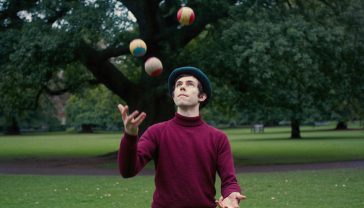Discover Ukiyo-e Art: The Historic & Influential Japanese Style
Dive into the world of Ukiyo-e, where vivid woodblock prints captured Japan’s floating world and left a lasting mark on art history.
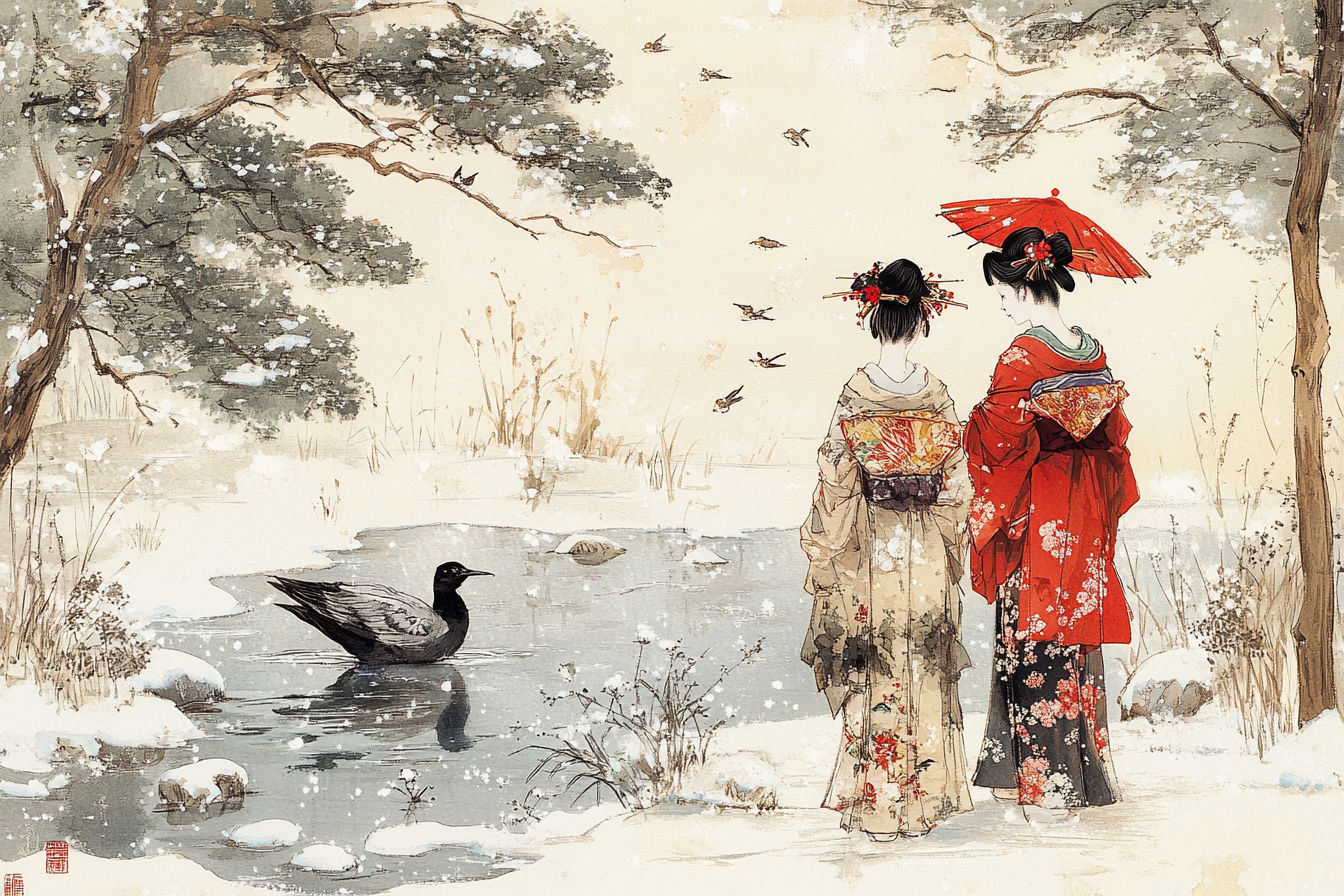
This post may contain affiliate links. If you make a purchase through these links, we may earn a commission at no additional cost to you.
Ukiyo-e (pronounced oo-kee-yo-eh) is a traditional form of Japanese art that emerged during the Edo period (1603-1868). The term literally translates to “pictures of the floating world,” which reflects the genre’s focus on depicting the fleeting beauty and experiences of urban life. The “floating world” referred to the lifestyle of the merchant class in cities like Edo (modern-day Tokyo), characterised by entertainment districts, kabuki theatre, sumo wrestling, and courtesans. It became a way to capture the spirit of this dynamic cultural scene.
What makes it particularly distinct is its use of woodblock printing, which allowed for mass production of art. This technique made it possible for a wide range of people to own beautiful prints, democratizing art ownership in a way that was rare for the time. These prints typically featured various subjects, including landscapes, famous actors, beautiful women (bijin-ga), and scenes from folklore. Each piece served not just as an artwork but also as a visual snapshot of the interests and lifestyles of the period.
Ukiyo-e evolved, influenced by cultural and political changes in Japan, and eventually left a lasting mark on global art movements. Its influence extended to Western artists like Vincent van Gogh and Claude Monet, who found inspiration in its bold compositions, use of colour, and innovative perspectives.
Ukiyo-E Origins and History
Ukiyo-e’s history begins in Japan’s Edo period (1603-1868), a time marked by relative peace, economic growth, and cultural flourishing under the Tokugawa shogunate. The rise of a prosperous merchant class led to the emergence of a new urban culture, which gave birth to the concept of the “ukiyo,” or “floating world” – a realm of transient pleasures found in entertainment districts, theatres, and teahouses. As demand grew for affordable art that depicted the lifestyles and interests of this burgeoning class, the woodblock prints became popular, offering glimpses into the vibrant scenes of everyday life.
The earliest Ukiyo-e artworks were monochromatic ink paintings and book illustrations from the 17th century, but the genre soon embraced woodblock printing as a primary medium. This technique made it possible to reproduce artworks in large quantities, making them accessible to a wider audience. The introduction of colour prints in the 1760s, known as “nishiki-e” (brocade pictures), marked a significant development, allowing artists to create multicoloured images that brought a new level of vibrancy to the prints.
As the style evolved, different themes and styles emerged. In the early years, prints focused heavily on depictions of kabuki actors (yakusha-e) and beautiful courtesans (bijin-ga). The late 18th century saw artists like Kitagawa Utamaro gain fame for their delicate portrayals of women, while the 19th century introduced iconic landscape artists like Katsushika Hokusai and Utagawa Hiroshige, who captured Japan’s natural beauty in prints like The Great Wave off Kanagawa and the Fifty-Three Stations of the Tōkaidō series.
However, by the late 19th century, it began to decline due to the rapid modernisation of Japan during the Meiji Restoration. Western art techniques, photography, and changing tastes reduced the demand for traditional woodblock prints. Nevertheless, it experienced a revival as Western collectors and artists, captivated by its unique style, helped preserve its legacy. This “Japonisme” movement significantly influenced Western art, especially Impressionism and Art Nouveau.
Today, Ukiyo-e remains a celebrated art form, appreciated for its historical significance and lasting impact on global aesthetics.
Understanding Ukiyo-e Woodblock Prints
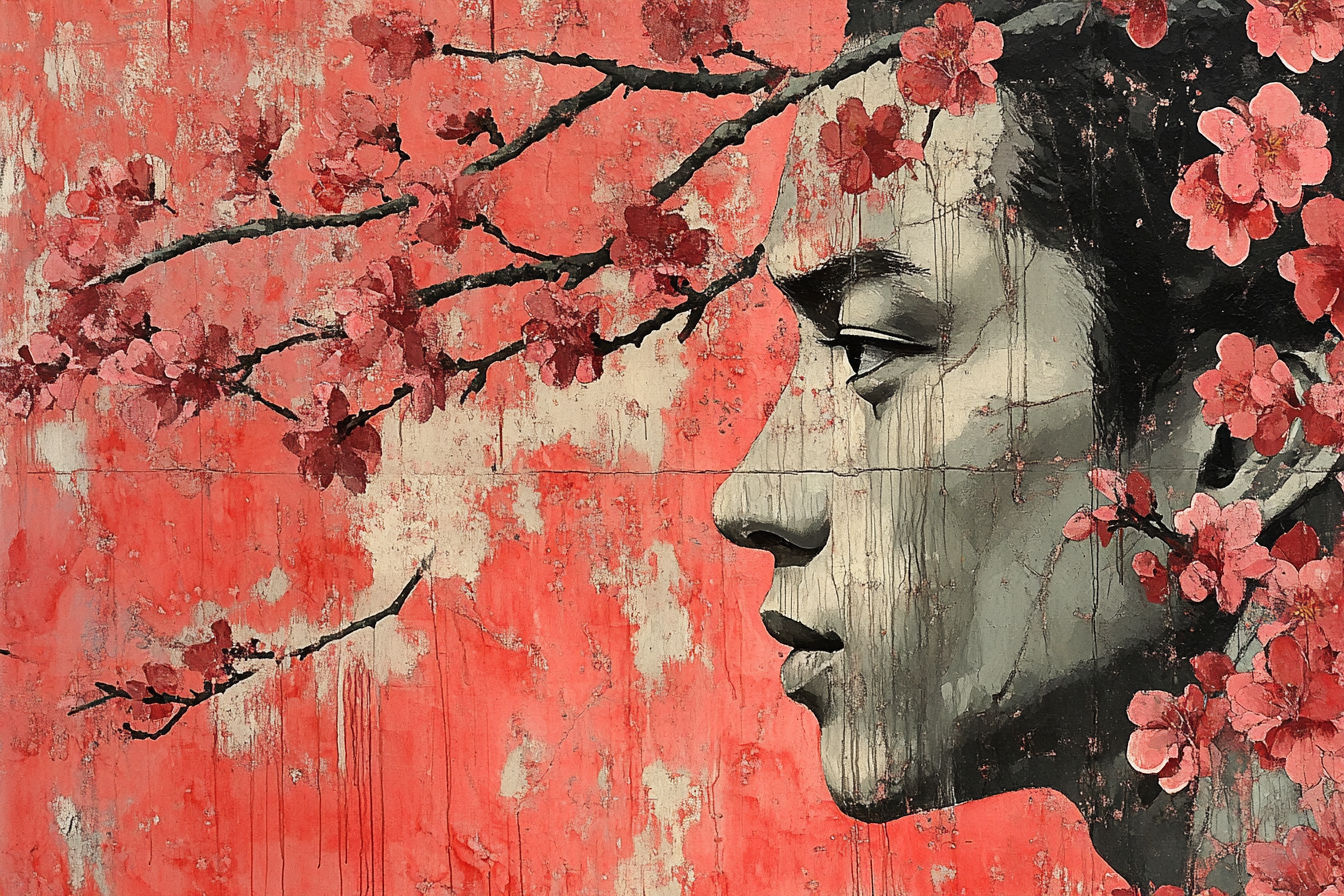
Ukiyo-e woodblock printing is a collaborative art form involving multiple skilled craftsmen. The process consists of four main roles:
- the artist (who creates the initial design),
- the carver (who cuts the design into woodblocks),
- the printer (who applies ink and makes the prints), and
- the publisher (who finances and oversees the production).
This teamwork allowed for the efficient mass production of prints, which contributed to its widespread popularity.
Ukiyo-e Technique and Process
The Ukiyo-e woodblock printing process involves several detailed steps, each requiring precision and skill to achieve the final artwork. Here’s a deeper look into how these prints are made:
Design Creation
The process begins with the artist, who creates the initial design, usually on thin paper using ink. This preliminary drawing, known as the “hanshita-e”, serves as the blueprint for the print. Artists like Hokusai and Hiroshige were known for their intricate and expressive designs, which captured scenes from nature, urban life, and mythology.
Carving the Woodblocks
The hanshita-e is pasted face-down onto a cherry wood block. Cherry wood is preferred due to its hardness and fine grain, which allows for intricate details. The carver then meticulously chisels around the lines of the drawing, creating a relief pattern on the block. The raised areas will hold the ink for printing, while the carved-away sections remain uninked. For multicoloured prints, separate blocks are made for each colour, requiring incredible precision to align (“register”) the blocks correctly. This technique is called “kento”, involving carved notches to guide the alignment of the paper.
Ink and Colour Application
Traditional Ukiyo-e prints used natural pigments made from minerals, plants, and even seashells. Colours like indigo, safflower red, and sumi ink were common. To add depth and subtlety to the print, the printer gradually fades the ink on the block to create a gradient effect. This method required skilful control of ink application to achieve seamless transitions between colours.
Printing the Design
The printer applies the chosen colour ink to the woodblock using a brush. The handmade paper, typically “washi”, which is known for its durability and texture, is then carefully laid onto the inked block. A tool called a “baren” is used to press the paper against the block, transferring the ink onto the paper. Each colour is printed one at a time, with the paper being repositioned for each colour block to build up the final image.
Finishing Touches and Quality Control
After printing, the prints are sometimes enhanced with additional touches like metallic pigments or embossing, known as “karazuri”. Quality control is essential to ensure that colours align correctly and impressions are consistent. The publisher, who oversees the entire production, would determine if the print met quality standards.
The collaborative and technical nature of woodblock printing made it a distinct art form, combining artistry and craftsmanship in equal measure. Its production process helped bridge the gap between fine art and popular culture, influencing both traditional Japanese aesthetics and international art movements.
The Art Style of Ukiyo-e
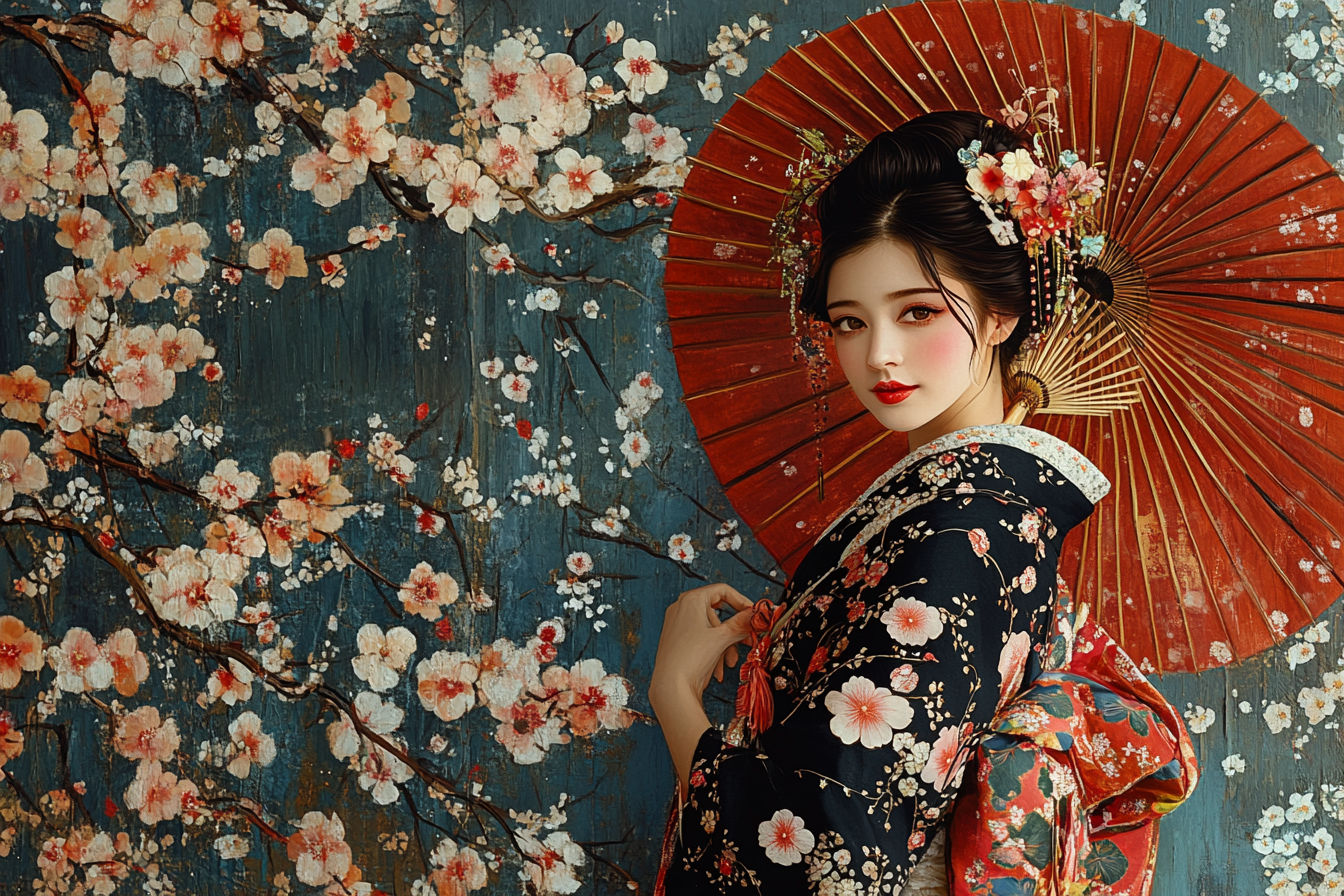
The art style is characterised by its bold compositions, vivid colours, and unique approach to perspective and line work. The subject reflects the daily life, culture, and interests of Edo-period Japan, often capturing the “floating world” of entertainment and urban experiences. Key themes included portraits of kabuki actors, beautiful women, landscapes, historical scenes, and stories from folklore. The style’s evolution over the centuries introduced distinct characteristics that made it both recognizable and influential.
Visual Characteristics and Techniques
Ukiyo-e prints typically feature bold outlines that define shapes and figures, creating a stylized appearance distinct from the realism of Western art. This emphasis on line work gives the art a graphic quality that has influenced many modern art movements. Colours are typically flat and vivid, with minimal shading, although techniques like “bokashi” (gradual colour fading) added depth and atmosphere to some prints.
Perspective is different from Western linear perspective. Artists employed methods like “bird’s-eye view” or used overlapping to suggest depth, rather than relying on vanishing points. This approach created dynamic compositions where every element contributed to the overall aesthetic rather than serving as background or foreground.
Common Themes and Motifs
- Portraits of Kabuki Actors (Yakusha-e)
Artists like Toshusai Sharaku became famous for their exaggerated and expressive portraits of kabuki actors. These prints captured the dramatic poses and facial expressions of the performers, providing a visual record of theatre culture. - Beautiful Women (Bijin-ga)
The portrayal of women, particularly courtesans and geisha, was a prominent theme. Artists like Kitagawa Utamaro depicted women with graceful lines and elaborate clothing patterns, often emphasizing their elegance and allure. These works not only highlighted beauty but also conveyed aspects of fashion and social status. - Landscapes (Fūkei-ga)
The 19th century saw a shift in focus to landscapes, with artists like Hokusai and Hiroshige leading the way. Works such as Hokusai’s Thirty-Six Views of Mount Fuji and Hiroshige’s The Fifty-Three Stations of the Tōkaidō series captured Japan’s natural beauty and famous landmarks, using colour and composition to evoke a sense of place. - Historical and Mythological Themes
Prints also depicted famous historical battles, samurai warriors, and scenes from folklore and mythology. These prints were not only decorative but served as a form of storytelling, bringing legends and historical events to life.
Influence on Other Art Forms and Movements
Ukiyo-e significantly impacted Western art, especially during the late 19th century when artists like Vincent van Gogh, Claude Monet, and Edgar Degas collected and were inspired by these prints. The movement known as “Japonisme” saw European artists adopting elements such as bold outlines, asymmetrical compositions, and a focus on everyday scenes. This influence contributed to the development of Impressionism, Art Nouveau, and even modern graphic design.
The distinctive style, with its combination of traditional techniques and creative experimentation, remains a celebrated art form that continues to inspire artists worldwide.
Renowned Ukiyo-e Artists and Their Works
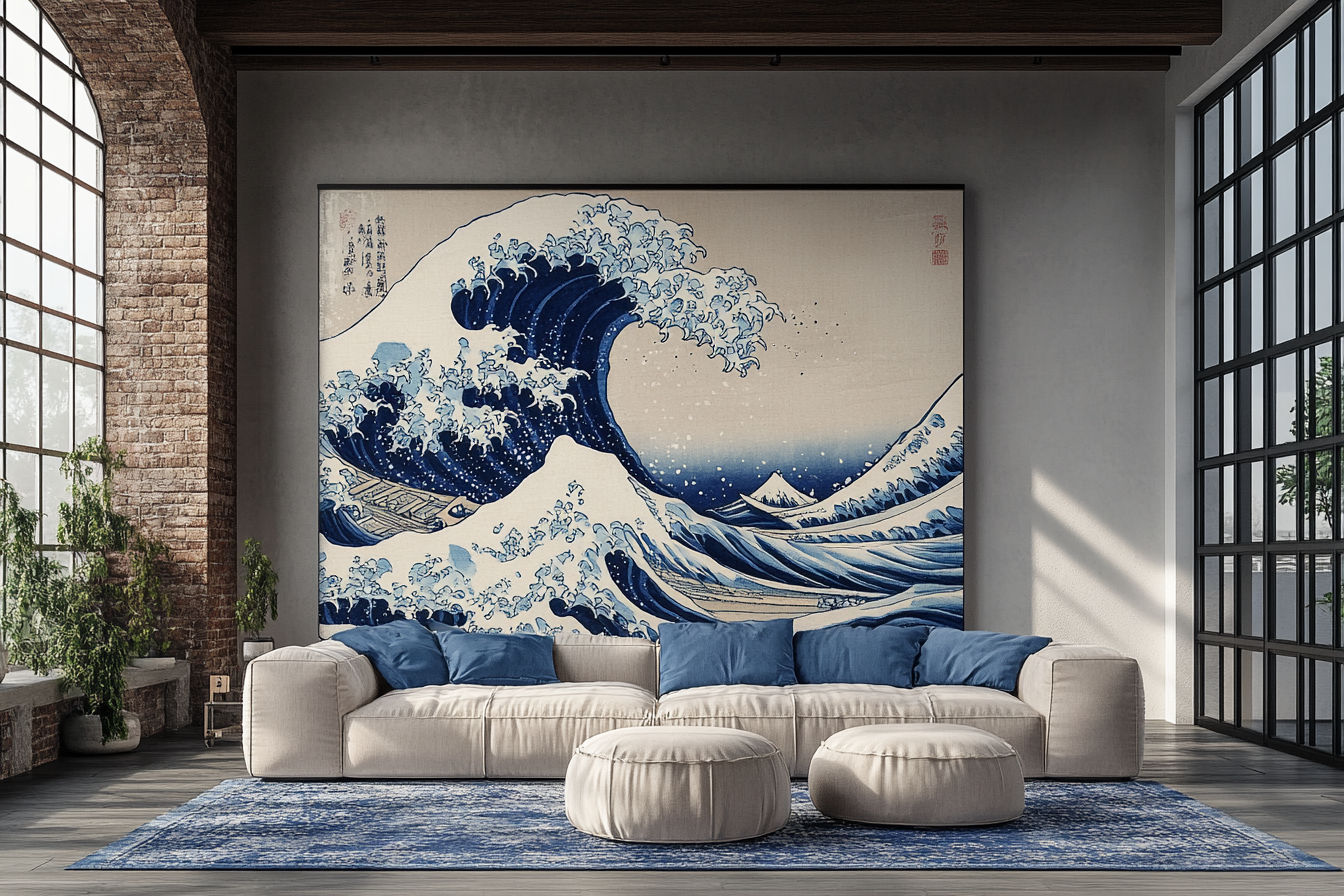
Ukiyo-e produced many influential artists, each bringing a unique style and focus to the genre. These artists not only helped shape the visual culture of their time but also left a lasting legacy on global art. Here are some of the key figures who defined it, and their notable works:
1. Katsushika Hokusai (1760-1849)
Hokusai is perhaps the most well-known Ukiyo-e artist, known for his innovative approach to composition and nature themes. His most iconic work, The Great Wave off Kanagawa, is part of the Thirty-Six Views of Mount Fuji series, which captures various perspectives of Japan’s sacred mountain. The use of dramatic perspectives, striking colour contrasts, and dynamic movement in this series exemplifies Hokusai’s influence on both Japanese and Western art. Hokusai’s works often explored not only landscapes but also animals, flowers, and even ghosts, demonstrating his versatility and curiosity about the natural and supernatural worlds.
Learn more about Katsushika Hokusai
2. Utagawa Hiroshige (1797-1858)
Hiroshige was a master of landscape prints and is best known for his series The Fifty-Three Stations of the Tōkaidō, which depicts scenic views along the Tōkaidō road, the main travel route between Edo (Tokyo) and Kyoto. His works are characterised by their tranquil beauty, delicate colour gradations, and atmospheric effects, such as rain, snow, and mist. Hiroshige’s ability to capture the changing moods of nature and the daily life of travellers helped solidify his reputation as one of Ukiyo-e’s great landscape artists.
Learn more about Utagawa Hiroshige
3. Kitagawa Utamaro (1753-1806)
Utamaro was renowned for his portraits of women (bijin-ga), capturing the elegance, grace, and beauty of courtesans and geisha. His depictions of women often emphasized delicate facial features and elaborate hairstyles, showcasing not just the subjects themselves but also the fashions and cultural aesthetics of the time. Utamaro’s works, such as Ten Studies in Female Physiognomy, brought a psychological depth to the portrayal of women, influencing both his contemporaries and later artists.
Learn more about Kitagawa Utamaro
4. Toshusai Sharaku (active 1794-1795)
Sharaku’s career was brief but impactful. He is best known for his expressive portraits of kabuki actors, which typically portrayed exaggerated facial expressions and dramatic poses to convey the intensity of theatrical performances. His style was distinctive for its boldness and psychological insight into the characters, making his works stand out in the realm of actor prints (yakusha-e). Though Sharaku’s identity remains somewhat mysterious, his influence on Ukiyo-e portraiture is undeniable.
Learn more about Toshusai Sharaku
5. Suzuki Harunobu (1725-1770)
Harunobu was a pioneer in the development of full-colour printing (nishiki-e), which replaced earlier monochrome and limited-colour techniques. He popularized bijin-ga prints that depicted idealized images of beautiful women, often with a poetic or seasonal theme. Harunobu’s works are recognised for their delicate line work and refined compositions, which helped establish the visual language of Ukiyo-e.
Learn more about Suzuki Harunobu
Legacy and Impact of These Artists
The works of these artists defined the genre and had a profound impact on the development of art both in Japan and internationally. Their prints reached European audiences in the 19th century, influencing movements such as Impressionism, where artists like Van Gogh and Monet incorporated elements into their styles. The bold lines, flattened perspectives, and unique compositions that characterised Ukiyo-e continued to inspire modern graphic design and illustration.
The Decline and Revival of Ukiyo-e
It experienced both a decline and revival, reflecting changes in Japan’s cultural landscape and international interest in the art form. While it thrived during the Edo period, several factors led to its decline by the late 19th century. However, the genre later experienced a resurgence that helped preserve its legacy.
Decline During the Late 19th Century
The decline began with the Meiji Restoration in 1868, a time of rapid modernization and Westernization in Japan. As the country sought to industrialize and adopt Western cultural and artistic practices, traditional art forms like Ukiyo-e lost prominence. Several factors contributed to its diminishing popularity:
- The Rise of Photography
Photography, introduced to Japan during the Meiji era, offered a new and more realistic way to capture images. As photographic techniques improved and became more accessible, the demand for prints, which once served as a primary form of visual documentation, began to wane. - Western Art and Modernisation
With Japan opening up to Western influences, the artistic tastes of the public shifted towards Western painting techniques, oil paintings, and new art movements. Western-style realism and linear perspective started to overshadow the traditional aesthetics. Additionally, art schools began focusing on Western techniques, reducing the emphasis on traditional woodblock printing. - Industrialization and Changing Markets
The socio-economic changes during the Meiji era led to shifts in consumer culture. The merchant class that had been the primary patrons of Ukiyo-e became less influential, and new forms of entertainment, such as Western-style theatres and modern publications, emerged, further reducing the demand for traditional prints.
Revival and Preservation Efforts
Despite the decline, it found a new life through Western appreciation. In the late 19th century, Ukiyo-e prints began to reach Europe and the United States, where they fascinated collectors and artists. European artists, including the Impressionists and Post-Impressionists, were particularly influenced by its unique compositions, use of colour, and perspectives.
Key figures who helped revive interest include:
- Western Collectors and Scholars
Collectors such as Siegfried Bing and scholars like Ernest Fenollosa played a crucial role in preserving prints by collecting and studying them. Their efforts contributed to the establishment of Ukiyo-e collections in major museums worldwide. - Japanese Preservationists
In Japan, there was a growing recognition of the need to preserve traditional art forms as symbols of national heritage. Institutions and collectors began to archive and exhibit prints, helping to restore appreciation for the art within Japan itself.
Contemporary Appreciation and Influence
Today, Ukiyo-e is celebrated not only as a historical art form but also as an ongoing source of inspiration. It continues to influence modern graphic design, manga, animation, and even fashion. Exhibitions are regularly held around the world, and many contemporary artists draw on its techniques and themes in their work, ensuring that the spirit remains alive.
This revival has secured Ukiyo-e’s place as a significant cultural and artistic tradition, bridging the past and present in both Japanese and global art.
Conclusion
Ukiyo-e, or “pictures of the floating world,” is a quintessential Japanese art form that captures the vibrant culture of the Edo period through its distinctive woodblock prints. Emerging from a time of urbanisation and cultural blossoming, it provided a visual record of entertainment, fashion, and natural beauty, making art accessible to the broader public. Its development from monochrome prints to multicoloured masterpieces allowed artists to push creative boundaries, resulting in stunning works that are celebrated worldwide.
The genre’s history reflects both the evolution of Japanese society and the influence of external factors. While it faced a decline during Japan’s rapid modernization in the Meiji era, its revival through Western appreciation and domestic preservation efforts helped ensure its survival. The international fascination with it played a key role in preserving the genre and integrating its visual language into global art movements, such as Impressionism, Art Nouveau, and even contemporary design.
Ukiyo-e’s enduring legacy lies in its ability to bridge traditional and modern aesthetics. The techniques and themes explored by artists like Hokusai, Hiroshige, Utamaro, and Sharaku continue to inspire creatives across various fields, from fine art and graphic design to manga and animation. Today, it remains a symbol of Japan’s cultural heritage and artistic ingenuity, reminding us of the timeless appeal of capturing life’s fleeting beauty.
As Ukiyo-e evolves with the times, it stands not only as a relic of the past but as a living art form that continues to influence and resonate in the modern world. Its story of decline and revival serves as a testament to the enduring power of art to transcend cultural and temporal boundaries.





